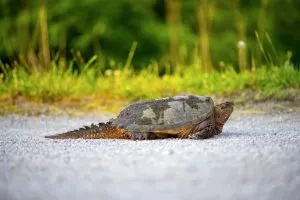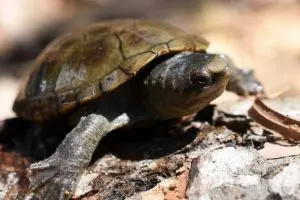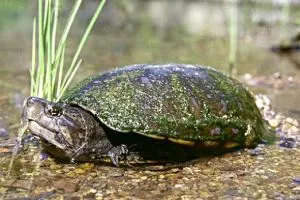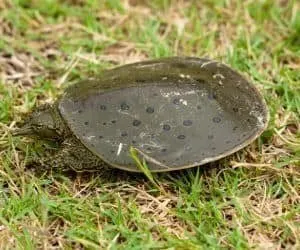There are 10 types of turtles in Arizona. Not only are there some cool turtles and tortoises here, but it’s also home to the Grand Canyon which was formed by the Colorado River.
The climate is humid and a semi-arid climate. As it is a drier climate, it is home to fewer turtles species than other states.
Turtles in Arizona
1. Common Snapping Turtle

Quick Fact
- Experience level: Intermediate
- Family: Chelydrida
- Scientific Name: Chelydra Serpentina
- Common Name: Common Snapping Turtle
- Average Adult Size: 12-15 inches, they can get as big as 19 inches
- Life Span: 30 – 50 years
- Average Price Range: Approximately $25-60
- Conservation Status: Least concern
The Common Snapping Turtle is one of the most common turtle species. It’s scientific name is a hint to their serpent like behaviour.
Their necks have the ability to quickly make a 180 degree turn, allowing them to snap at predators.
Their jaws are extremely strong and have the ability to crush bone. They are omnivorous but prefer meat over vegetation. They hunt within the water for animals or insects to eat.
They aren’t native to Arizona, and are mostly found within water bodies. They prefer water with muddy bottoms, and can often be found at the bottom of their habitats.
2. Painted Turtle

Quick Fact
- Experience level: Beginner
- Family: Emydidae
- Scientific Name: Chrysemys picta
- Common Name: Painted Turtle
- Average Adult Size: 5 – 7 inches
- Life Span: 20 – 30 years
- Average Price Range: Approximately $100
- Conservation Status: Least Concern
The Painted Turtle has 4 different subspecies including the Western, Eastern, Midland and Southern Painted Turtle.
Although each species may differ slightly, their overall behaviour is similar. They look as if they have been painted with yellow, red or orange stripes. Their shells are smooth and darker in colour.
Their skin varies from olive to black. Females tend to be larger than the males.
They are omnivorous and eat aquatic animals, and vegetation. Their diets predominantly consist of insects, snails, and crustaceans.
They are known to hibernate in winter in the wild, however Arizona’s climate rarely gets cold enough for it to be necessary.
They hunt at the bottom of waterbeds and are most active during the day. They will leave the water to bask during the day on logs, or rocks.
3. Ornate Box Turtle

Quick Fact
- Experience level: Intermediate
- Family: Emydidae
- Scientific Name: Terrapene ornata ornata
- Common Name: Ornate Box Turtle
- Average Adult Size: 5-7 inches
- Life Span: 40 – 60 years
- Average Price Range: Approximately $30 – 100
- Conservation Status: Near Threatened
Ornate Box Turtles have a beautiful pattern on their shell that is sometimes described as a starburst pattern.
Their skin is gray with white or yellow spots on it, and the males head occasionally has green in it.
There is little distinction between males and females, however males are often smaller than females. In hot weather, the water is important in order to help the turtle regulate its temperature as they are reptiles.
They hibernate underground in burrows during cold weather, and have the ability to survive frozen soil for a number of days.
They tend to have a shy temperament, and do not like being excessively handled. It’s best not to approach them suddenly in the wild.
They are known as opportunistic feeders, and are omnivorous. They will eat whatever is available to them in their location or during the season, and commonly eat grasshoppers, fruits, vegetables and other insects.
4. Pond Slider

Quick Fact
- Experience level: Beginner
- Family: Emydidae
- Scientific Name: Trachemys scripta
- Common Name: Pond slider, red-eared slider
- Average Adult Size: 5 – 11 inches
- Life Span: 30 years
- Average Price Range: approximately $20
- Conservation Status: Least concern
Pond sliders are semi aquatic turtles and include the red eared slider, yellow belly slider and cumberland slider in the grouping. They are very popular pets, mostly because they start out cute and small and are available cheaply.
Juvenile Pond Sliders have a yellow underbelly, and a green upper shell. They have yellow and green stripes on their skin.
As they age, the markings on their skin fade. Their skin becomes close to black in colour with few visible markings. Their shells are oval with knobs in the centre.
Males normally have larger front claws than females, and females have a longer, thicker tail.
The Pond Slider has webbed feet as it is an aquatic animal. As their name suggests they prefer ponds, rivers or any slow moving water bodies.
5. Arizona Mud Turtle

Quick Fact
- Experience level: Intermediate
- Family: Kinosternidae
- Scientific Name: Kinosternon stejnegeri
- Common Name: Mud Turtle, Arizona Mud Turtle
- Average Adult Size: 6 – 7 inches
- Life Span: 40 years
- Average Price Range: Approximately $70 – $120
- Conservation Status: Least concern
The Arizona Mud Turtle are one type of mud turtle and are smaller turtles that let off a foul smell from glands on the sides of their bodies if they feel threatened.
They can be found in water bodies such as rivers, ponds, lakes or creeks.
When the weather is extremely hot or dry, they will burrow underground where there is mud to keep them cool.
During the winter and cold weather, they will hibernate underground as well. They have been noted to go vast distances across land in search of water.
The top of their shells are brown with hints of yellow, and the bottom of the shell is yellow. Their shells are oval in shape.
They are omnivorous and eat both insects and vegetation available to them.
6. Yellow Mud Turtle

Quick Fact
- Experience level: Intermediate
- Family: Kinosternidae
- Scientific Name: Kinosternon flavescens
- Common Name: Mud Turtle, Yellow Mud Turtle
- Average Adult Size: 4-5 inches
- Life Span: 40 years
- Average Price Range: Approximately $300
- Conservation Status: Least concern
The Yellow Mud Turtle is another type of mud turtle and is semi-aquatic and will spend as much time on land as they will in the water.
Their habitats are sandy areas, and water bodies such as lakes, rivers and ponds. Their main diet consists of fairy shrimp, and they will forage for food in the water and on land. They are omnivorous, and eat a variety of insects and vegetation.
The upper part of their shell is flattened, and varying degrees of brown to olive or black in colour, and they have dark brown edges around their scutes.
Their skin is olive, and the males tail has a sharp or horny end. As with other mud turtles, the Yellow Mud Turtle also lets off a foul smell when they feel threatened.
7. Sonora Mud Turtle

Quick Fact
- Experience level: Beginner – Intermediate
- Family: Kinosternidae
- Scientific Name: Kinosternon sonoriense sonoriense
- Common Name: Sonora Mud Turtle, Mud Turtle
- Average Adult Size: 7 inches
- Life Span: 40 years
- Average Price Range: Approximately$65 – $120
- Conservation Status: Near threatened
The Sonora Mud Turtle is primarily aquatic but has been noted to travel on land between bodies of water. As with most other mud turtles, they are omnivorous and feed on small animals and insects, as well as vegetation.
They prefer to live in streams, lakes or ponds. They are an isolated species, and won’t be found in many areas besides Arizona, New Mexico and Mexico.
Due to their loss of natural habitats and human intervention, they have become a more threatened species. Their skin is brown with yellow lines, and their shell is olive-brown with keels on it.
8. Agassiz’s Desert Tortoise

Quick Fact
- Experience level: Beginner
- Family: Testudinidae
- Scientific Name: Gopherus agassizii
- Common Name: Desert Tortoise
- Average Adult Size: 9-15 inches
- Life Span: 50 – 80 years
- Average Price Range: Illegal to purchase a desert tortoise
- Conservation Status: Vulnerable
The Agassiz’s Desert Tortoise has become a vulnerable species and was named after the Zoologist Jean Louis Rodolphe Agassiz.
They spend the majority of their time in their rocks, burrows, and pallets to help keep their temperature regulated. They have longer life spans as they are able to survive water, salt and water imbalances.
Their front limbs have sharp claws with scales on them and assists them in digging. Their back legs are long and thin. Their diets are herbivorous and they primarily eat plants like herbs, herbs, wildflowers and cacti fruits and flowers.
9. Sonoran Desert Tortoise

Quick Fact
- Experience level: Beginner
- Family: Testudinidae
- Scientific Name: Gopherus morafkai
- Common Name: Morafka’s Desert Tortoise, Sonoran Desert Tortoise, Desert Tortoise
- Average Adult Size: 14 inches
- Life Span: 35 – 40 years
- Average Price Range: Illegal to purchase a desert tortoise
- Conservation Status: Vulnerable
The Sonoran Desert Tortoise lives east of the Colorado River, and this distinguishes them from the Agassiz’s Desert Tortoise who is found on the west of the Colorado River.
They are terrestrial tortoises and are herbivorous. They primarily eat leaves, stems and flowers. They spend the majority of their lives in their shelters, and only come out to bask in the sun, breed or feed.
They have been noted to store food in their shelters as well. The Sonoran Desert Tortoise has a strong digestive system due to bacteria in their digestive system.
This allows them to eat plants that other animals aren’t able to digest.
10. Spiny Softshell

Quick Fact
- Experience level: Intermediate/expert
- Family: Trionychidae
- Scientific Name: Apalone spinifera
- Common Name: Spiny Softshell Turtle
- Average Adult Size: 5 – 20 inches
- Life Span: 40 – 60 years
- Average Price Range: Approximately $50 – 150
- Conservation Status: Least Concern
The Spiny Softshell is a flat aquatic turtle. They are more vulnerable as their shells are soft compared to other turtle species.
They are one of the largest aquatic turtle species, but not as large as sea turtles. Their feet are webbed to assist them in the water, and each foot has three claws on it.
They live in fresh bodies of water and are commonly found in rivers, lakes, or ponds. Their diets consist of crayfish, mussels and insects but will also feed on aquatic vegetation such as algae.
The Spiny Softshell is brown to olive in colour, and they sometimes have splotched markings across their shells. Typically they become darker in colour as they age.
Conclusion
Those were the 10 turtles and tortoises in Arizona which included a wide variety. The majority of turtles found are mostly aquatic and found in rivers, ponds and lakes.
The most common species is the mud turtle and Arizona is home to three subspecies of mud turtles.
Other nearby states
- Turtles in California
- Turles in Nevada
- Turles in Utah
- Turles in Colorado
- Turles in New Mexico
- Turles in Mexico

Mary Aguirre
Thursday 1st of December 2022
If I was to send you a picture, can you tell me what kind of tortoise do I have?